Keywords are one the most important aspects of your OpenAsset system. They can save your users countless hours by helping to surface the projects and files they need at the click of a button. However, optimizing your keyword usage can be a fine balancing act. If assets are under-tagged, they won’t appear in searches and your firm is unlikely to derive value from them. On the other hand, if assets are tagged with too many keywords that are too granular then this results in different problems. Terms may be too specific to ever be searched for, results will be limited to one or two options – discounting other potentially suitable assets, and system upkeep will become a nightmare. Without getting this balance right, and without implementing efficient strategies to tag your files, keywords can actually drain your time – completely counteracting the value they should bring.
This blog is designed to provide you with some tangible guidance to ensure your keywords work for you, and not against you. We’ll discuss how you can uncover files with limited keywords and what tactics you can use to quickly tag these files. We’ll then delve into how you can evaluate keyword usage, and what processes you can apply to ensure you’re proactively staying on top of your keywords in the future. Let’s get stuck in!
Identifying Projects & Files with Limited Keywords
The first thing to do when evaluating your keyword practices is to consider whether there may be any keyword gaps across your system. Unless you’re either new to OpenAsset or have been extremely thorough in your tagging processes, there will likely be some gaps you’re unaware of. While there are no hard and fast rules on the exact number of keywords you should have on any project or file – different systems work for different teams – we do recommend taking stock of your keyword usage to understand whether adding (or in some cases removing) keywords might make sense.
Project Keyword Gaps
It’s worth remembering that your project keywords are of particular importance as they trickle down to all of the files within that project (this is explained in more detail in this blog). Therefore, it makes sense to tackle any project keyword gaps first.
To filter projects to those with limited keywords you can use the Data tab on the left side of the Projects page. There are a few options from here. A good first step would be to filter on projects that contain less than five keywords. While we say there are no set rules for the number of keywords that should be applied, any project with less than five keywords could almost certainly be optimized. Another option would be to filter on projects that are missing specific keywords. This can be helpful when you might class some keywords as mandatory. For example, you might want to always capture where your projects are based, so searching on ‘Location: City has no keywords’ can quickly uncover projects that need tagging.
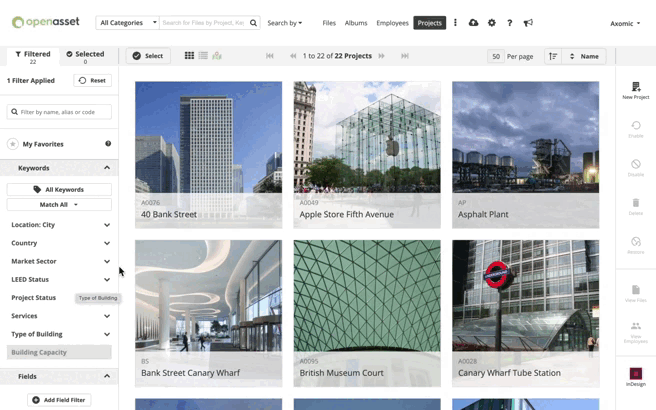
File Keyword Gaps
To filter files to those with limited keywords, you can use search filters. Under the ‘Search by’ dropdown, you can navigate to ‘Keyword count’ and enter your parameters. Note that this count is specific to file keywords, and doesn’t count any project keywords that the file inherits. Again, there is no specific rule for the number of keywords your file should include, but somewhere between 3 to 10 is a typical range. Adding too many keywords can actually be counterproductive as the keywords become too time-consuming to add and are too niche to provide much value in terms of searchability.
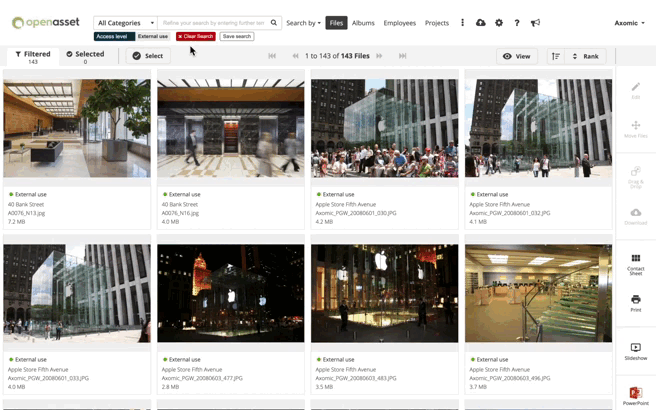
Tagging Files Efficiently
Once you’ve identified the projects and files that need more keyword coverage, there are a few tactics you can employ to tag them at speed.
Using Project/File Arrows
Having filtered your projects or files to those that contain a limited number of keywords, you can click on the first project/file and navigate to the keywords tab. A basic, but perhaps overlooked solution to tagging keywords at speed is to simply remain in this tab, using the page arrows to sift to your next selected file or project. This may not be rocket science, but it can save a lot of time compared to reverting back to your project or file home screen and clicking on the next project/file to edit.
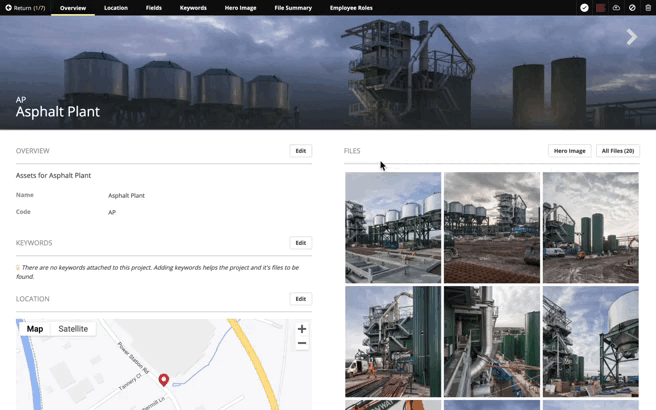
Using Similar Images
OpenAsset’s AI feature, Similar Image search, is another great way to tag files at speed. Again, a good first step would be to filter on files with limited keywords. Next, you would hover on the first image, click on the ‘More’ button, and ‘Select all’ of the similar images. These similar images may not all be lacking Keywords, but likely some in the selection will. You would then navigate to your selection, hit ‘Edit’, and apply Keywords that are shared across all of the images. For example, in the recording below we’re adding the Keyword ‘Exterior’ to all of the similar images that are surfaced, before de-selecting a couple of files, and adding the Keyword ‘Brick’ to the remainder.
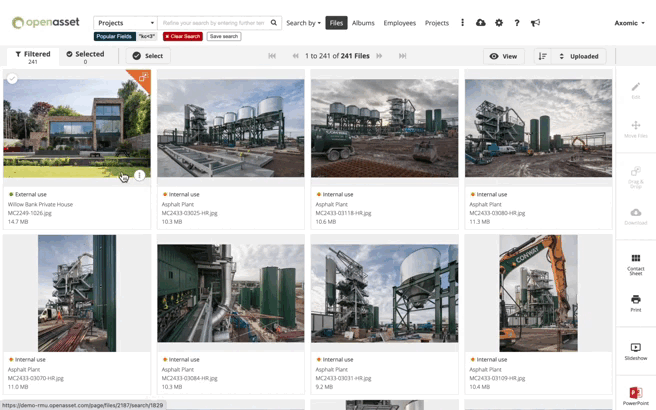
Of course, AI isn’t perfect (yet!), so it’s worth double-checking your selection before applying a Keyword to every file in it. However, even if there’s the odd file that doesn’t share the same feature, these can be quickly deselected (as shown above), leaving the remaining files to be tagged. You would then repeat this process with other files in your initial search (those lacking Keywords), and you should soon see the number of files with limited Keywords dropping.
When Removing Keywords Might Make Sense
While we’ve covered how to identify projects and files lacking keywords, it can be just as advantageous to discover keywords that are lacking files or projects. If you have keywords that are only tagged to a few files then it’s worth questioning, do you really need that keyword in your taxonomy? Of course, the question is sometimes yes – after all, there may be a distinctive feature that is uncommon amongst your files. However, more often we see that when keywords are only tagged to a relatively low number of files they may be worth abandoning. This may mean deleting the keyword, or it could mean merging the keyword with another related term. For example, if you have only a few assets tagged with the keyword ‘chair’, it might be worth merging this keyword into the broader term ‘furniture’ to ensure the assets remain discoverable. In general, there is no right or wrong answer regarding the granularity of your keywords, rather you will learn from experience and gut feeling as to whether certain words will improve your search experience.
To discover keyword usage, you can navigate to the taxonomy page, find the file taxonomy type you are interested in, and look for the number next to the keyword. You can also sort by ‘Attached files’ to get a quick overview as to which are tagged frequently and which are not. To remove a keyword from your system, you would select it and hit Delete.
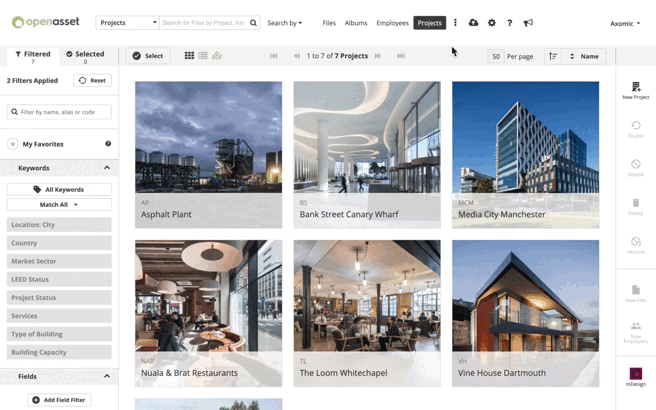
Proactive Steps to Stay On Top of Your Keywords
The above steps provide guidance on how to react to a system that is lacking in keyword coverage, but it’s also worth adopting processes to proactively stay on top of your system. Using upload approvals and regularly evaluating your keyword usage are two ways in which you can do this.
Upload Approvals
Upload approvals ensure that whenever a new file or batch of files is uploaded, an ‘approver’ (generally the system admin) has the chance to approve or deny the upload. This step allows a gatekeeper to check that keywords are applied and ensure they are relevant to the file. This not only checks that images are being tagged with keywords but is also useful to ensure users aren’t going overboard with their keywords by applying overly granular image tags. Learn more about upload approvals here.
Regular Evaluations
Another step to ensure your system’s keywords are working for you is to simply conduct frequent reviews of your keywords. A quarterly review of your keywords can help you evaluate what’s working, and what’s not. A great way to perform this review would be to sit with your team and sift through your platform’s taxonomy. You can ask your team how they search through OpenAsset and whether any keywords are redundant. This is particularly important during the first year of using your OpenAsset system, as not only are you collectively learning what makes sense to include in your taxonomy, but it also ensures you’re building a well-structured keyword foundation for the future. Our support team can aid you in this analysis by exporting your keyword usage into CSV format so that the data is more easily digestible.
Getting Started
Getting the right balance of keywords in your system is important for a smooth and consistent system. While it can seem intimidating and even time-consuming to get your keywords in order, once you have a system that works it will save you countless hours in the long run.
Of course, our team is always on hand to help out, so if you need assistance please don’t hesitate in reaching out to your dedicated Customer Success Manager. Alternatively, reach out to our Support team, here.



